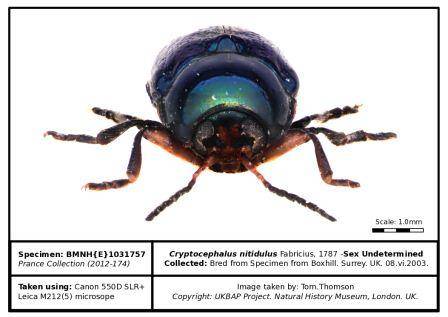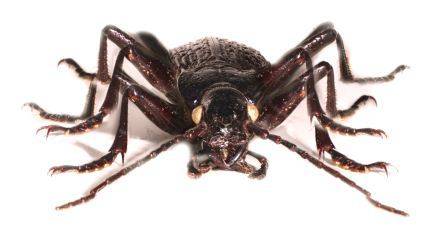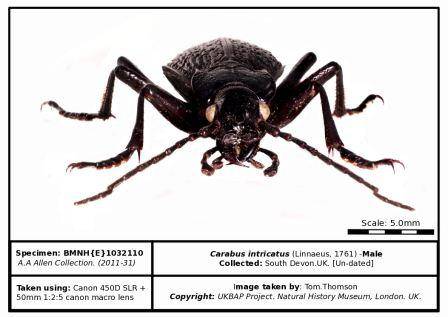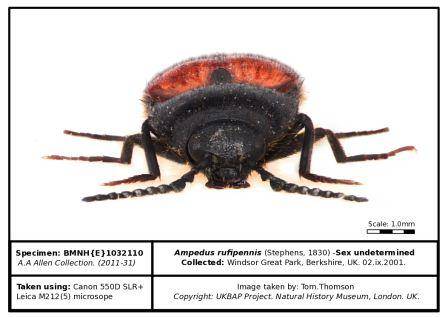Here Tom Thomson, who is our lead researcher on the Coleoptera section's UKBAP project website, tells us a bit about the project and some of the interesting challenges of documenting Museum specimens! The UK Biodiversity Action Plan was first published in 1994, as part of the UK Government’s response to the Convention on Biological Diversity (CBD). It set out to describe the biological resources (including beetles!) of the UK in order to help conserve and aid recovery of species under threat or endangered.
'Good day Friends, Romans and fellow Coleopterists!
An update for you on interesting and sometimes perplexing things encountered while working on many many lovely beetles from our collections as part of the Museum’s Biodiversity Action Plan species inventory of specimens and publication project (soon to be available on a scratchpad).
This project came about to address the balance in resources available to researchers working with these species all of which by definition are rare or endangered. Many resources and organisations such as the The National Federation of Biological Recorders (NFBR), and the NBN Gateway and other media often are unable to take account of the historical distribution of invertebrates of conservation importance through archive data. Considering that within the NHM collections we have thousands of specimens going back to the early 19th century and beyond, (complete with specimen labels giving the distribution of species dating to a period before widespread habitat loss and pollution) this data is of incurable worth and highly significant.
Knowing the present and historical distribution of a species is essential for any conservation work. In fact, many species are given conservation status specifically because they have declined, in many cases provable by the data available to ascertain if their present distribution is less than their historical distribution. These former (wider) distributions can throw light on reasons for decline, and historic records may show modern day recorders valuable pointers for possible additional sparse populations of rare taxa, and estimate what their geographical limits might have been under more favourable conditions.
Of course the majority of information on the historical distribution of species is locked up in major museum collections and given the access possible via new online media is a great opportunity to bring ready transcribed label data, comprehensively checked and in a reliable form into open circulation from material that otherwise would often be difficult to interpret without expert curatorial assistance.
This often extremely cryptic data including collectors handwritten notes, habitat data and often multiple observations from generations of collectors and researchers on particularly old material is of international use and value and this projects’ main aim is to make this freely available to the whole conservation community for all UKBAP species of Coleoptera, to allow them to paint a more realistic picture of species’ distribution and status in the UK.
So onto the images that are an essential research to accompany this data, Well as many of you will probably know (and may well have some
experienced first-hand), getting high quality images of any small specimen is always a challenge, but something as complex and 3D as a preserved beetle (getting all the legs right up to the tarsi in focus particularly) can be more so than many things. Thankfully as technology is advancing fast in this area over recent years the better our computers and electronics in general become. For photographing most organisms we have moved on from manual cameras and spending long hours squinting down a view- finder fine focusing on tiny details; those days of developing negatives only to find that one diagnostic feature is blurred when you were sure it looked lovely and sharp when you took the image are now gone!
So the advent of a digital camera as a readily available tool both as compact pocket types with good inbuilt macro facilities right through to full digital SLR's with dedicated macro lens and the ability to connect directly to a computer is such a gift to us entomologists I am sure you will agree! The ability to operate things shack-free on remote right from the computer screen has really changed things for the better as well as being able to see the results in seconds not hours or days even more so!
In recent times, the biggest change of all is the advent of sophisticated software to combine images of differing focal lengths and merge them into a single smooth crisp image. For some subjects this makes the previously impossible relatively easy. Views of small organisms and their wider background are improved by being both crisp in focus, way outside the normal depth of field of even the best lens and far better quality than single images dodged and burnt on a film negative projector. The power to combine 20, 50 or even 100 images into one polished finished frame is priceless. For imaging work possible with the more traditional methods, it can have its downsides when left on its automatic settings; combining frames as shot as demonstrated by this image below of the ground beetle Carabus intricatus.
These types of error are relativity easy to fix however, and this is the finished image:
Thankfully this is a rather drastic example! For the most part it’s a wonderful quick and smooth process with results like this:
Carabus intricatus dorsal view
This image took only 20 minutes with microscope and camera and less than this in the software.
The other end of the spectrum though is this fine specimen of Ampedus rufipennis in frontal view which is composite of 156 images and took around two hours to take with a similar amount to smooth and blend in the software.'






cintricatus.jpg)
